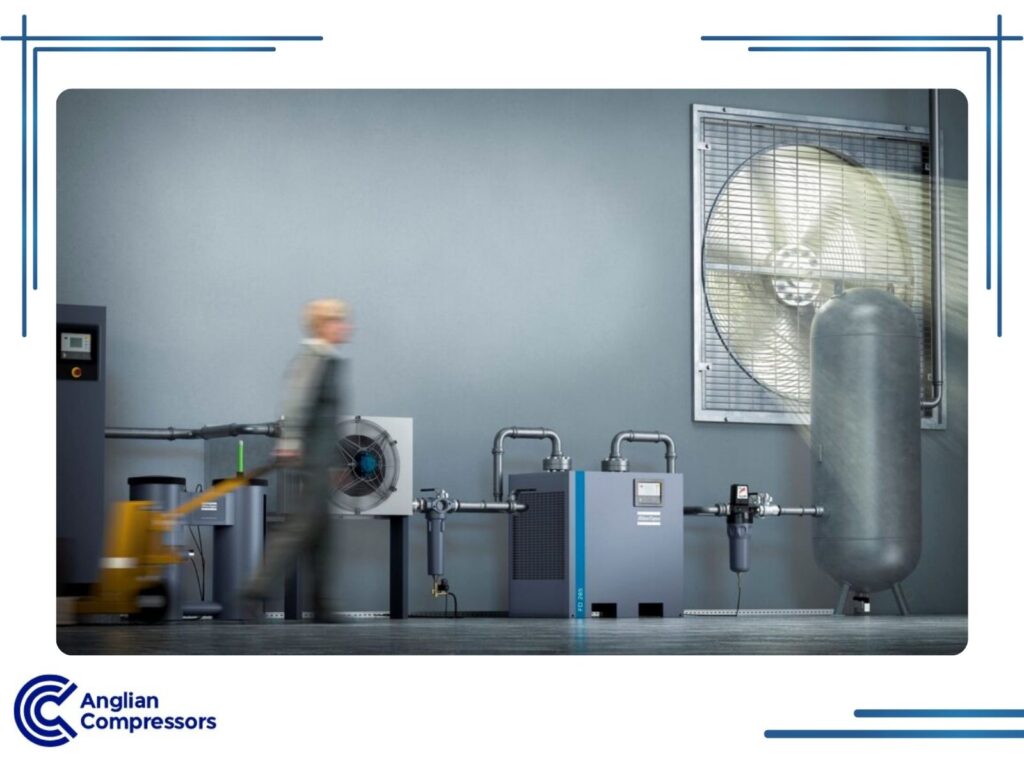What are Compressed Air Dryers?
Compressed air dryers are essential for removing excess moisture and toxins from compressed air systems. Removing moisture from compressed air extends the lifespan of industrial equipment such as pneumatic tools significantly, reducing your maintenance costs in the process. In some industrial applications, a compressed air dryer is crucial for eliminating microorganisms and preventing contamination.
In this guide, we introduce you to the different types of compressed air dryers and explain how they work. We’ll also help you determine which compressed air dryer to buy and how to maintain it.
If you’re in doubt and need a professional’s insight, don’t hesitate to contact our compressor and dryer specialists – it’s always better to choose the correct dryer the first time, when it comes to the safety of your valuable equipment.
Table of Contents
What are Compressed Air Dryers?
Compressed air dryers reduce the amount of toxins, oil and moisture within compressed air systems. They pull out and remove any moisture in your compressed air, essentially “drying” it.
Some air compressors already include a built-in aftercooler, which can reduce moisture levels in compressed air by up to 70%. However, if you operate in a highly humid environment or carry out tasks that demand a high dryness level, you may need to consider adding an additional dryer.
Why You Need Compressed Air Dryers
Atmospheric air, as in the air all around you, naturally contains some water vapour. The temperature of the air has a significant impact on how much moisture it contains (the hotter the air, the more moisture).
As air rapidly pressurises inside a compressed air system, heat and water vapour are released, which can cause condensation to form inside your machinery. For example, if the air is 20°C and humid, using a compressor at 7 bar pressure can release up to ten litres of water per hour. This water can cause issues such as rust and contamination in the pipework and machines it flows through.
The Pressure Dew Point (PDP)
The temperature at which the moisture in the compressed air system becomes water vapour is called the pressure dew point (PDP). A low PDP value indicates a small amount of water vapour in your compressed air system. You’ll need to pay attention to the PDP when choosing the most appropriate dry compressed air dryer for your needs.
Two Main Types of Air Compressor Dryers
The two main types of air compressor dryers are desiccant and refrigerant. Which one you should buy depends on your budget, your compressed air system, and the specific tasks you need to carry out.
Remember – if you need any assistance at all, we’re just a phone call away.
Refrigerant Air Dryers
Refrigerant air dryers cool the temperature of the compressed air to about 3°C (37°F), which turns the water vapour into dry air. The two main categories of refrigerant dryers are cycling and non-cycling; non-cycling dryers are simple and cost-effective, but less energy efficient than their cycling counterparts.
Applications
Refrigerant air dryers work well with most rotary screw compressors, though we recommend high-temperature versions for piston air compressors. Especially non-cycling versions, refrigerant air dryers tend to be budget-friendly, simple to install and easy to operate. This accessibility makes them the industry standard for most settings.
Pros and cons
Non-cycling dryers are cost-effective and dependable, but because they use about the same amount of energy, whether you need a lot of air or just a little, they can lack efficiency. Cycling dryers use extra components to automatically turn on and off as needed, making them more energy efficient. They generally cost more to purchase, but can result in savings in the long run.
Desiccant Air Dryers
If you need dryers that deliver the air quality you need to manufacture food or pharmaceuticals, you’ll need desiccant air dryers.
Rather than cool down the air, desiccant air dryers use chemicals that bind to and remove moisture. Desiccant air dryers can reach a PDP as low as -40°C, making them much more effective than their refrigerated counterparts.
Applications
Desiccant air dryers are most commonly used in industrial applications where the quality of the compressed air is crucial, such as in the manufacturing of pharmaceuticals, food and drinks, electronics, dental and medical equipment, and painting and coating.
Pros and cons
If high-quality air is a priority, desiccant air dryers are hard to beat. Plus, thanks to their efficiency, they boast relatively low running costs. However, they are more expensive to purchase upfront than refrigerated dryers, and the additional expense isn’t always warranted. Further, many rely on purge air for drying the desiccant media, which can result in costly waste.
The Importance of Regular Professional Check-Ups
By allowing a trained professional to inspect your compressed air dryers from time to time, you can catch small problems before they exacerbate. Maintenance tasks may include checking desiccant beds, changing filters, and verifying the performance of cooling systems in refrigerated dryers.
While it can be tempting to delay inspections – particularly when you need to keep a close eye on cash flow – specialist maintenance can help you save hundreds (if not thousands) of pounds in the long run.

Compressed Air Dryer Preventive Maintenance Tips
In between professional check-ups, doing your own maintenance will go a long way at minimising problems before they escalate.
- Regularly Check and Replace Filters: Filters are the first line of defence against dirt and debris. Inspect them frequently and replace them according to the manufacturer’s recommendations.
- Monitor Condensate Drains: Ensure that condensate drains are functioning properly and free of clogs. Accumulated moisture can lead to corrosion and reduced dryer efficiency.
- Inspect Desiccant (if applicable): For desiccant dryers, check the desiccant material regularly for signs of degradation or saturation. Replace it as needed to maintain optimal drying performance.
- Check for Leaks: Air leaks can significantly impact dryer performance and lead to energy waste. Regularly inspect all connections and fittings for leaks and repair them promptly.
- Schedule Professional Maintenance: Consider scheduling annual or bi-annual maintenance visits from a qualified technician. They can perform thorough inspections, identify potential issues, and perform necessary repairs or adjustments.
By investing a little time and effort in preventive maintenance, you can extend the life of your compressed air dryer, reduce downtime, and save money on costly repairs. Remember, a well-maintained dryer means clean, dry air and a more efficient operation for your business.
Common Issues and Solutions
- Desiccant Replacement: In desiccant dryers, the desiccant material has a limited lifespan, which means it needs replacing periodically for your dryer to maintain efficiency.
- Clogged Filters: Filters in air dryers can become clogged over time, adversely affecting their performance. Keep your dryer in full working order by changing the filters regularly.
- Cooling System Problems: In refrigerant dryers, the cooling system is critical. Problems with the refrigeration components can lead to reduced drying efficiency.
- Leak Detection: Air leaks in the system can reduce the effectiveness of the dryer. Don’t forget to check for and repair any leaks frequently.
Find the Most Suitable Air Compressor Dryer for You
Air compressor dryers play an indispensable role in maintaining the quality and performance of your compressed air systems. By purchasing modern and reliable air compressor dryers, you can minimise your operating costs, while maximising operational efficiency and mitigating business risks. Since your air dryer will be essential in the day-to-day running of your business, you should ask a specialist for advice.
At Anglian Compressors, we’ve been a leading distributor and installer of compressors, compressed air dryers and related equipment since 1977. If you need advice or want to find out how our solutions can help you save energy, cut costs and improve your bottom line, don’t hesitate to contact us for a no-obligation chat.


